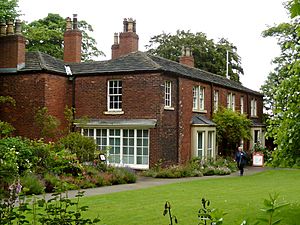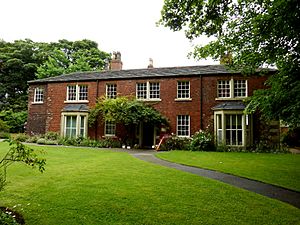Red House Museum facts for kids

Red House Museum, Gomersal
|
|
| Established | 1974 |
|---|---|
| Location | Oxford Road, Gomersal, West Yorkshire, England BD19 4JP |
| Type | Historic house museum |
The Red House Museum was once a fascinating historic house in Gomersal, West Yorkshire, England. It was built way back in 1660 and later updated in the fancy Georgian style. Even though it closed its doors as a museum at the end of 2016, it's still a very important building, protected as a Grade II* listed building.
Contents
A Look Back: The History of Red House
The Red House was built by a man named William Taylor in 1660. His family had lived in Gomersal for over a hundred years before he built this new brick house right next to their old one. The Taylors were farmers and also made cloth. Over time, their business grew, and they became successful cloth merchants.
The original old house was still standing in 1713. Workshops around it were full of tools and materials for making cloth. The old house was probably taken down when a barn and a coach house were built in the mid-1700s.
The Red House got its name because it was made of red brick. This was quite unusual in a village where most buildings were made from local sandstone. The outside and inside of the house were changed and updated during the 1700s. Later, in 1920, the windows in the living room and dining room were made bigger.
In January 1967, the house was given a special Grade II* listing. This means it's a very important building because of its history, its connection to industry, and its place in literature. It still has some beautiful parts from the Georgian period, like a staircase, fireplaces, and windows, all built into the original 1600s structure. The barn and coach house are also interesting.
The local council, Spenborough Council, bought the house in 1969. Five years later, in 1974, it opened its doors as a museum for everyone to visit.
Exploring the Architecture
Outside the House
The Red House has two floors and is built from red brick with stone corners called quoins. Its roof is made of stone slates. The front part of the roof is hipped, meaning it slopes on all four sides, while the back has four gables (the triangular parts of a wall under a sloping roof).
The main door is not exactly in the middle of the house. On either side of the door, there's a sash window and a canted bay window (a window that sticks out from the wall at an angle). Upstairs, there are three double sash windows and two single ones. The back wall, with its four gables, was rebuilt between 1995 and 1997.
Inside the House
The inside of the house is decorated and furnished to look like it did in the 1830s. This was when Joshua Taylor, a woollen cloth maker who owned a mill nearby, lived there with his wife Anne and their six children.
When you entered the house, you would see an 18th-century staircase. It has thin wooden balusters (the small posts that support the handrail) and leads up to a landing from the same time period. The entrance hall has wooden features painted to look like wood grain, a popular style in the Georgian era. Portraits of the Taylor family hang on the walls, showing family members from 1737 to 1817. These include Joshua Taylor's sister Deborah, his parents John and Anne, and his father-in-law Captain Tickell.
The parlour, dining room, study, governess' room, scullery, kitchen, and bedchambers (bedrooms) are all set up to show what life was like in the 1830s. They are filled with furniture from the 19th century. The dining room has stained glass windows with pictures of famous writers William Shakespeare and John Milton. There's also a painting of the 1794 eruption of Mount Vesuvius, which is mentioned in the novel Shirley. Many rooms have 18th-century hob grates or iron fire grates. These were special fireplaces with ledges built into them for heating food in pots and pans.
Gardens and Other Buildings
The garden at Red House was designed to look like a 19th-century garden. It has green lawns, sweet-smelling old climbing roses, a cozy arbour (a shady spot made of climbing plants), and flower beds filled with old-fashioned flowers. You can also see a display of old gateposts on the lawn.
To the west of the house, there's a two-story stone barn with a stone slate roof and a large opening for carts. The stone coach house has four open arches. Its inside has been carefully restored.
Famous Visitors and Connections
The Red House had some famous visitors! John and Charles Wesley, who were important Methodist preachers, were friends with John Taylor (William Taylor's great-grandson) and visited the house.
Another famous visitor was Charlotte Brontë, a well-known writer. She had been a student at Roe Head with Mary Taylor, who was the daughter of Joshua Taylor. Charlotte Brontë used the Taylor family as inspiration for the "Yorkes" family in her novel Shirley, and the Red House itself became "Briarmains" in the book. Reverend Lauten of Gomersal Moravian Church, who visited in the 1840s, might have inspired the Moravian minister character in Shirley.
Mabel Ferrett (1917–2011), a poet, publisher, and local historian, worked at the museum. She wrote a book called The Taylors of the Red House in 1987.
The Museum's Closure
Due to government funding cuts, Kirklees Council decided it could only afford to run two museums in the area. This meant that Red House, along with the Tolson and Dewsbury Museums, was at risk of closing. The Council for British Archaeology Yorkshire noted that the council wanted to save a lot of money by 2017–18.
People who loved the museum, including friends of the museum and literary groups (especially those interested in the Brontë connection), were very upset about the possible closure. They campaigned hard to keep it open. However, Kirklees Council closed the Red House Museum on December 21, 2016. The items from inside the museum were either stored or moved to other places, and the building was put up for sale.
The building remained unsold for some time. By June 2018, nearly £30,000 had been spent just on keeping it maintained. The Red House was finally sold at an auction in December 2024 for £650,000.




